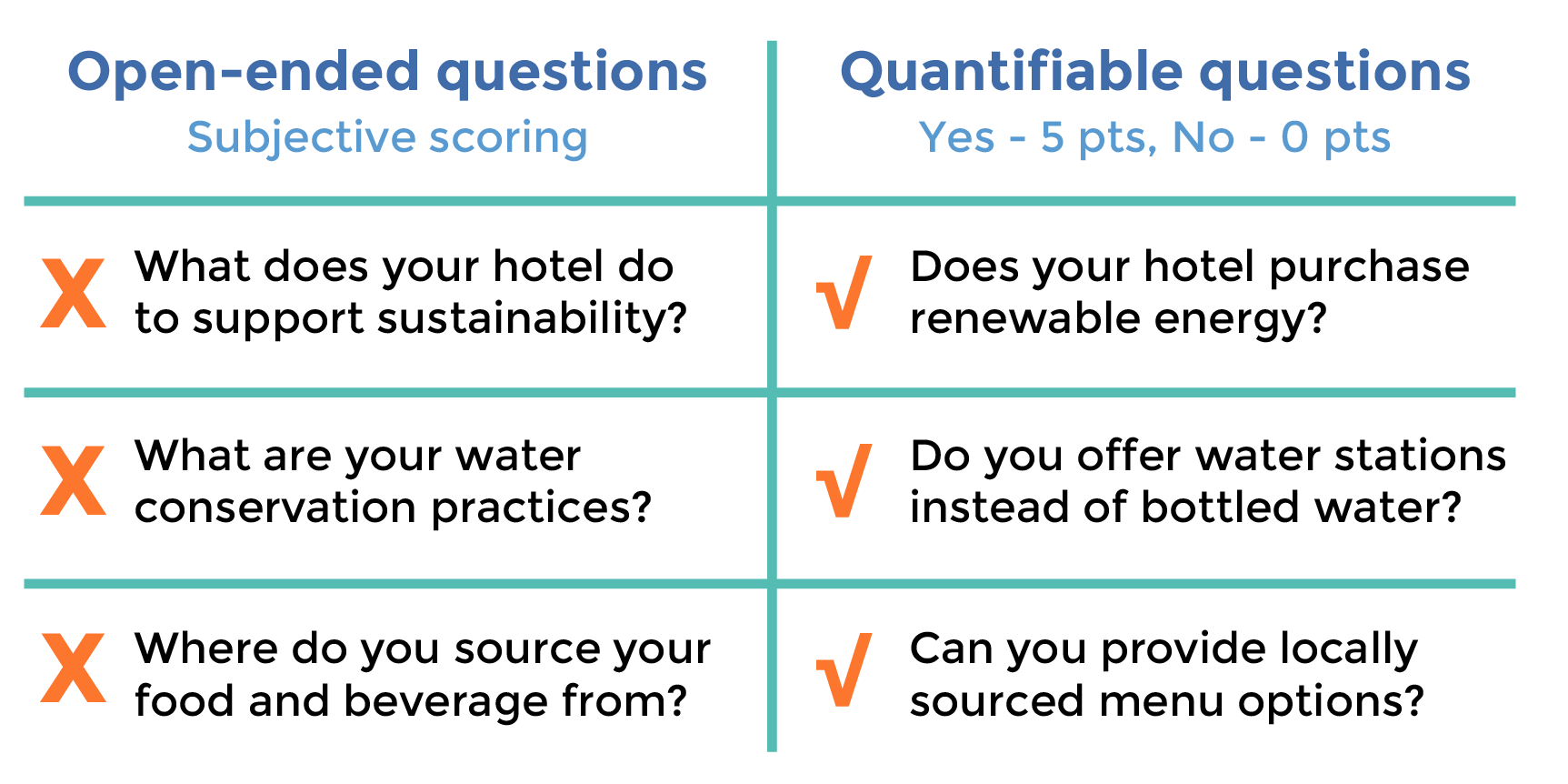Procurement professionals don’t have time to create every request for proposal (RFP) from scratch. Which is why so many use a simple RFP template to kickstart their e-sourcing process. When built properly, RFP templates can save an enormous amount of time.
In fact, by developing an RFP questions template, you can fast-track your next procurement project. Templates also allow you to skip the time-consuming process of collecting question data. Instead, you can focus on tailoring the necessary RFP content and planning the project review.
Check out these best practices to get the most value out of your RFP templates.
8 request for proposal template best practices
Start every RFP template with a detailed overview. It should paint a clear picture of the history of your company and your needs. Tell vendors as much as you can about your current RFP process
. For example, if your office is decentralized and half the team works in another timezone or if a new solution needs to be in place by the end of the year. The more context you can provide, the better.
At a minimum, even a simple RFP template should include:
- Business overview and history
- Project name, goals and background
- RFP point of contact information
- Submission deadline and instructions
This information helps vendors understand your perspective, expectations and desired outcome(s). Use this section in your RFP templates to demonstrate why your company needs the solution. Clearly articulate why you are seeking their product or service. The additional information will help them to provide better answers to your questions, which will save you time in the long run.
Comparing vendors is hard, but your RFP template can make it easier. Include as many questions as possible that are measurable to create a clear comparison. Open-ended questions leave room for ambiguity. In other words, they create grey areas that take time to interpret, complicating the review process. Use multiple choice questions rather than essay questions. Then you can weight each option in order of preference. This makes it easier to compare vendor responses and confirm critical decision points.
For example, if you’re planning an event and want to ensure that the prospective host hotels’ sustainability values match your own, you can include quantifiable questions in your hotel RFP template.

To get the best answers, you have to ask the right questions. Work with stakeholders from the involved departments as well as IT and legal to determine your key criteria before you build a new template. The group should also define the ideal solution and highest priorities. This essential information will help establish your rubric for weighted scoring. If possible, share these insights with invited vendors.
RFP software with default scoring can significantly speed up evaluations. Scores are calculated instantly. This is a huge time-saver, especially if your RFP template includes dozens of detailed questions.
As you build a catalog of RFP templates to save you time, you’ll likely find that some of the questions and sections appear in multiple templates. Save even more time by categorizing and tagging RFP sections based on how you use them.
For example, create a section that covers your company’s standard terms and conditions to use in any type of RFP template. If you ask all technology vendors the same security questions, group them together. Then you can quickly insert the grouped questions into your technology RFPs. Or if every hotel RFP includes a list of concession questions, tag and bundle them together. The more grouped components you create, the easier it will be to drag and drop sections together to build the perfect RFP template.
In your template, explain your RFP process best practices so suppliers know what to expect. When possible, include all your questions and required documents in your RFP templates. Giving vendors all the information upfront will eliminate questions and roadblocks later. For some RFP types, this might not be realistic. In those cases, include a section to let vendors know what else they will need to prepare for as the process continues. For example, if there will be a second round of questions; or if they’ll soon be asked to fill out a security questionnaire. Give them a heads up in your initial RFP.
Additionally, let them know if you’ll be requesting any online or onsite meetings following your initial reviews. If you plan to invite shortlisted vendors to prepare a presentation, provide an outline of your expectations. This ensures the vendor comes prepared to meet your needs and can answer any additional questions you may have.
Include any terms and conditions like diversity requirements, conflict of interest policies, safety standards, delivery requirements and so on. In addition, outline the proposal submission and receipt terms so responses are received in your preferred format.
Attach examples of your contract and security questionnaire to the RFP template. And ask the vendor to identify any deal breakers early in the process. It’s better to understand supplier limitations as soon as possible. For example if they’re not able to comply with a key requirement like ensuring all servers are located on Canadian soil. Or if you need to have Spanish speakers available to train your team.
Include questions about what resources will be required to ensure a successful engagement. Request a list of anticipated key milestones and dates. You’ll want to know how much time your team will need to dedicate to this project and who will need to be a stakeholder.
For example, if you and your team will need to dedicate 100 hours of development work to ensure a smooth implementation. Everyone benefits from knowing this information in advance.
If you’ve never created a construction RFP template or hotel RFP template before, how do you know where to begin? Starting from scratch can be intimidating, even after you’ve asked your internal stakeholders for input about what questions to ask vendors.
Luckily, there are plenty of great RFP examples for almost every procurement situation. Just seeing what information other businesses request can help reassure you that you’re asking all the right questions.
Here are a couple of great RFP examples that can inspire your next RFP template.
Construction RFP example
Organizations that undertake frequent construction projects may find it useful to create a construction RFP template. The template could include sections that are unique to a construction RFP like project scope, subcontractors and supplier requirements, site visit details, and insurance and bonds.
For example, in 2015, Incourage Community Foundation issued a construction RFP to renovate a historic building. The RFP goes into detail about the community impact of the project, the property’s significance and the scope of services. It’s a great example of a construction RFP.
Incourage Community Foundation — Construction RFP example
Hotel RFP example
Many businesses and associations regularly use hotel RFPs to find host locations for annual conferences, employee incentive trips and workshops. A hotel template should include sections for sleeping rooms, meeting rooms, food and beverage, and requested concessions.
Every year, the National Association of Black Accountants (NABA) holds a national convention with more than 1,000 attendees. Their conference changes locations each year and has extensive meeting room requirements. Their hotel RFP, seeking bids for their 2021-2023 conferences, is incredibly detailed and clear.
NABA 2021-2023 Convention — Hotel RFP example
Marketing RFP example
Marketing RFPs solicit marketing services for brand promotion, special events or one-time projects. A marketing RFP provides detailed information about the company or project background, expectations, desired outcomes and scope of services.
To build awareness of an upcoming event, the WWII Commemoration Committee issued an RFP for marketing services. It outlines the organization’s event, their objectives and the experience required.
WWII Commemoration Committee — Marketing RFP example
Agency RFP example
Engaging an agency is a big investment. Having a thorough agency RFP template can help find the best vendor for the job and save the business both time and money. An agency RFP should include questions about past work, client collaboration practices and technical abilities.
When Monterey Peninsula College needed to have their website designed, they issued an agency RFP to solicit bids for the project. The RFP outlined platform specifications, visual design goals as well as details about their hosting and maintenance needs. It’s a great start for any agency RFP template.
Monterey Peninsula College — Web design agency RFP example
RFP templates are a key part of an optimized procurement process, but there’s always room for improvement. As your business grows and evolves, your RFP questions should adapt to meet the changing needs of the business. Set time each year to review what’s working and what should be updated.
If you consistently get unsatisfactory answers from your vendors for a particular question, review it to see how you can provide clarity. If you find that the RFP process is taking too long for quick projects, consider creating a simple RFP template or consider using a different RFx document.
Streamline the process with RFP software
RFP management software can help you create RFP templates so you can easily reuse questions, categorize and tag questions or sections and collaborate on updates.
For example, with Responsive you can:
- Build and customize RFP templates for any sourcing situation
- Search your knowledge library to help you find and reuse similar questions
- Segment and tag your questions or templates by industry, project, location and more.
- Work with your team in one version of the RFP to ensure transparency throughout the process
- Collaborate with vendors to issue updates, answer questions and track progress
- Leverage automated weighted scoring and side-by-side comparisons



